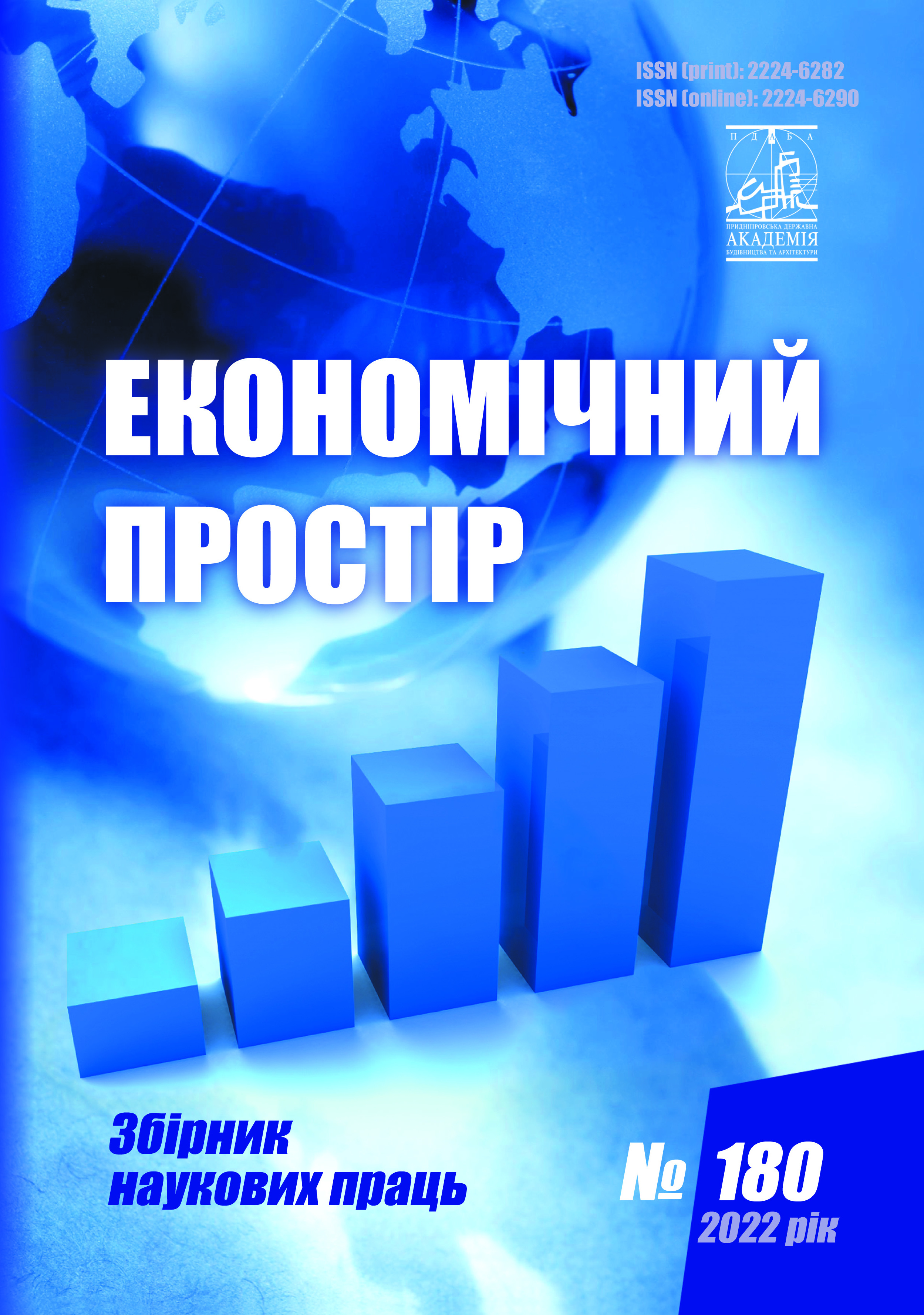APPLICATION OF CLOSED-CYCLE ECONOMY BUSINESS MODELS IN UKRAINIAN REALITIES
Abstract
The article defines that one of the alternatives to the linear model of production and consumption, the existence of which provoked the global problems of today, is the concept of the economy of closed cycles or the circular economy, which provides for resource-efficient production and consumption, the preservation of products and their parts in closed production and sales cycles and reduction of the negative consequences of human activity for the environment, which determined the relevance of the article. The essence and main purpose of using closed-loop business models is considered. On the basis of a critical analysis of research on this issue, the signs of such business models are highlighted. The prerequisites for the transition to the economy of closed cycles, as one of the most important mechanisms for overcoming the global problems of humanity, are analyzed. The main areas of the emergence of circular business models are characterized, the development of which will improve the forecast of global economic development (due to the reduction of resource limitations to growth and the creation of additional value in various sectors). The possibilities of using circular business models in modern conditions by Ukrainian companies, depending on the sphere of their activity, are revealed. The existing classifications of circular economy business models are considered.The classification developed by Accenture specialists, under the auspices of the Ellen MacArthur Foundation, focused on the implementation of technologies that contribute to the use of fewer resources for the production of products and / or services, was examined and analyzed in detail; extending the service life of existing products and/or services through repair and restoration; completing the life cycle of products by recycling them. This was achieved using general scientific methods (system analysis, formalization) and methods of economic and statistical analysis (graphical, grouping, classification); A conclusion was made about the need to apply the analyzed techniques to Ukrainian realities. The main elements of the circular production process were systematized. The practical value of the conducted research lies in the possibility of developing a "roadmap" for the transition to a circular economy at different levels of public administration, as well as the strategy of long-term and sustainable development of individual companies.
References
Linder M., Williander M. Circular Business Model Innovation: Inherent Uncertainties. Business, Strategy and the Environment. 2017. Vol. 26. Iss. 2. P. 182–196.
Scott J. T. The Sustainable Business a Practitioner’s Guide to Achieving Long-Term Profitability and Competitiveness. Greenleaf Publishing: Sheffield, UK, 2013. 236 p.
Mentink B. Circular Business Model Innovation: A Process Framework and a Tool for Business Model Innovation in a Circular Economy. Master’s Thesis, Delft University of Technology & Leiden University, Leiden, The Netherlands, 2014. 168 p. URL: http://www.tudelft.nl/islandora/object/uuid:c2554c91–8aaf-4fdd-91b7–4ca08e8ea621 (дата звернення 25.03.2022).
The EIB Circular Economy Guide. Supporting the circular transition. European Investment Bank, 2019. 24 p. URL: http://www.eib.org/attachments/thematic/circular_economy_guide_en.pdf (дата звернення 20.07.2022).
Dedicoat C. The importance of a circular economy. Cisco’s Technology News Site, 2016. URL: http://www.newsroom.cisco.com/feature-content?articleId=1738213 (дата звернення 14.07.2022).
An economic opportunity worth billions-Charting the new territory / World Economic Forum. 2016. URL: http://www.reports.weforum.org/toward-the-circulareconomy-accelerating-the-scale-up-across-global-supplychains/an-economic-opportunity-worth-billions-charting-thenew-territory (дата звернення 14.06.2022).
Тaking steps to create a circular IKEA. Ikea. 2017. URL: http://www.highlights.ikea.com/2017/circular-economy (дата звернення 25.07.2022).
Ellen MacArthur Foundation, “Towards the Circular Economy, Opportunities for the Consumer Goods Sector . (2013) URL: http://www.tinyurl.com/ztnrg24 (дата звернення 29.08.2021).
Hodes D. Advancing biofuels. Globa lCorporate Xpansion Magazine. 2013. URL: http://www.gcxmag.com/2013/04/advancing-biofuels/ (дата звернення 12.07.2022).
Botsman, R. The Sharing Economy Lacks a Shared Definition. Fast Company. 2013. URL: http://www.fastcoexist.com/3022028/the-sharing-economy (датат звернення 20.06.2022).
Lacy P., Rosenberg D., Drewell Q., Rutqvist J. 5 Business Models that are Driving the Circular Economy / FastCompany. 2013. URL: http://www.fastcoexist.com/1681904/5-Business-Models-That-Are-DrivingtheCircular-Economy (дата звернення 23.01.2022).
Становская А.В. Бізнес моделі циркулярної економіки та підходи до їх класифікації Вісник Полоцького державного університету. 2021. №14. С.72-80 URL: https://rep.bstu.by/bitstream/handle/data/10446/202-205.pdf?sequence=1&isAllowed=y (дата звернення 15.07.2022)
Linder M., Williander M. (2017). Circular Business Model Innovation: Inherent Uncertainties. Business, Strategy and the Environment. no. 26, iss. 2, pp. 182–196.
Scott J. T. (2013). The Sustainable Business a Practitioner’s Guide to Achieving Long-Term Profitability and Competitiveness. Greenleaf Publishing: Sheffield, UK, 236 p.
Mentink B. (2014) Circular Business Model Innovation: A Process Framework and a Tool for Business Model Innovation in a Circular Economy / Master’s Thesis, Delft University of Technology & Leiden University, Leiden, The Netherlands, 168 p. Available at: http://www.repository.tudelft.nl/islandora/object/uuid:c2554c91–8aaf-4fdd-91b7–4ca08e8ea621 (accessed 25.03.2022).
The EIB Circular Economy Guide. Supporting the circular transition / European Investment Bank, (2019). 24 p. Available at: http://www.eib.org/attachments/thematic/circular_economy_guide_en.pdf (accessed 20.07.2022);
Dedicoat C. (2016). The importance of a circular economy / Cisco’s Technology News Site, Available at: http://www.newsroom.cisco.com/feature-content?articleId=1738213 (accessed 14.07.2022);
An economic opportunity worth billions—Charting the new territory. World Economic Forum. (2016). Available at: http://www.reports.weforum.org/toward-the-circulareconomy-accelerating-the-scale-up-across-global-supplychains/an-economic-opportunity-worth-billions-charting-thenew-territory (accessed 14.06.2022).
Taking steps to create a circular IKEA. Ikea. (2017). Available at: http://www.highlights.ikea.com/2017/circular-economy (accessed 25.07.2022).
Ellen MacArthur Foundation, “Towards the Circular Economy, Opportunities for the Consumer Goods Sector . (2013). Available at: http://www.tinyurl.com/ztnrg24 (accessed 29.08.2021).
Hodes D. Advancing biofuels. Globa lCorporate Xpansion Magazine (2013). Available at: http://gcxmag.com/2013/04/advancing-biofuels/ (accessed 12.07.2022).
Botsman, R. The Sharing Economy Lacks a Shared Definition. Fast Company. (2013). Available at: http://www.fastcoexist.com/3022028/the-sharing-economy ( accessed 20.06.2022).
Lacy P., Rosenberg D., Drewell Q., Rutqvist J. 5 Business Models that are Driving the Circular Economy. FastCompany. (2013). Available at: http://www.fastcoexist.com/1681904/5-Business-Models-That-Are-DrivingtheCircular-Economy (accessed 23.01.2022).
Stankova A.V. (2021). Biznes modeli cy`rkulyarnlyi ekonomiky ta pidxody shhodo yix klasyfikaciyi [Сircular economy business models and approaches to their classification]. Visnyk poloczkogo derzhavnogo universytetu, no. 14, рр. 72-80 Available at: https://rep.bstu.by/bitstream/handle/data/10446/202-205.pdf?sequence=1&isAllowed=y (accessed 23.01.2018).



